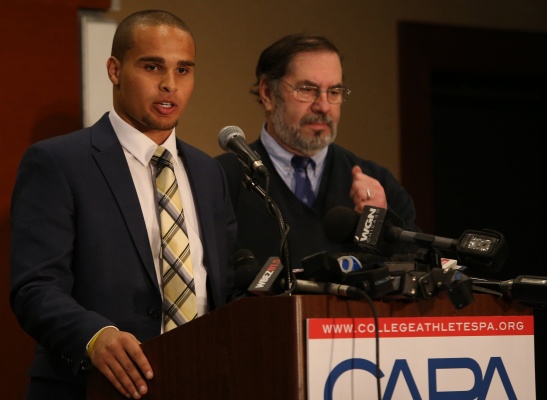O’Bannon Ruling Leaves Much to be Desired
MCT
Kain Coulter, quarterback at Northwestern University in Chicago, IL, speaks at a press conference regarding college athlete compensation. (Antonio Perez/The Chicago Tribune/VIA TNS)
November 8, 2015
College sports are a multibillion-dollar industry that is fueled by student-athletes who dedicate hours of time each week to practices and games. These overworked players are entitled to the money they generate for their universities. Some college coaches make upwards of seven million dollars a year, which is more than some of their professional counterparts.
The top conferences in the National Collegiate Athletic Association (NCAA) negotiate billion-dollar television contracts to broadcast games. As the industry grows, universities continue to bring in billions of dollars from their athletic programs and then proceed to invest more in their athletic facilities on campus. The coaches and the universities are getting their share of the pie, but due to the ruling in the O’Bannon v. NCAA lawsuit on Sept. 30, the athletes who bring in this money will continue to be unpaid.
In 2009, Ed O’Bannon, a former University of California, Los Angeles basketball player, filed a lawsuit against the NCAA. He alleged that the association violated the Sherman Antitrust Act and that the university committed actions which deprived him of his right to publicity, specifically in video games displaying his name, image and likeness. On Aug. 8, 2014, U.S. District Court Judge Claudia Wilken ruled that certain NCAA amateurism rules did in fact violate federal antitrust laws. Wilken also ruled that member schools would have to pay Division I football and men’s basketball players up to $5,000 a year for use of their name, image and likeness.
On Sept. 30, 2015, a three-judge panel from the United States Court of Appeals for the Ninth Circuit affirmed that the NCAA was violating antitrust laws; however, the panel ruled against the $5,000 compensation. This decision was reached because providing any form of compensation beyond the cost of attendance would, according to the panel, turn the NCAA into “minor league status.” This $5,000 compensation would not cut into the integrity of the game, as the players are deserving of the money they generate, but it would cut into universities’ profits, and that’s why the NCAA is so strongly against it.
This decision will particularly hurt those current and former student-athletes who have worked to ensure they and all future college athletes receive compensation for their services. For example, Kain Colter and the Northwestern Wildcats became the first college athletes to unionize in January 2014. Later that year, the NCAA announced new protocols for practices, including fewer contact drills and overall shorter durations. They have also hired independent doctors to evaluate players on the sidelines during games. While the NCAA’s small steps don’t exactly compensate for the billions that student-athletes make for the association, the NCAA is protecting its players more than ever before.
The O’Bannon ruling should provide some joy for student-athletes, as it was the first time a judge ruled that the amateurism of sports should not allow the NCAA to break antitrust laws. The universities under the NCAA umbrella will have to abide by certain guidelines for compensation of their athletes. This guarantees cost-of-attendance scholarships that go beyond academic tuition, but advocates for college sports reforms feel that this is not enough. The $5,000 figure was taken off of the table because Judge Wilkens did not provide enough evidence to show why capping the figure was lawful, yet the previous cap of zero dollars should be disallowed. The panel of judges believed that providing any sort of monetary reward unrelated to education would take away the amateur, student-athlete status of the players. Maintaining the amateurism of the sport, however, should not be as important as making sure the student-athletes get what they deserve.
While emphasizing that these players are student-athletes seems reasonable enough to deter universities from paying their players, recent scandals show that schools are placing more importance on the athletic side of things. In the last few years, the University of North Carolina has been involved in a string of academic fraud involving their football and basketball programs. Additionally, Rutgers and Notre Dame have been making recent headlines for attempting to interfere with the academics of some of their players. If colleges are going to treat their players as athletes first and students second, then these players should be compensated accordingly.
The ruling in the O’Bannon case essentially reiterated the fact the student-athletes will not be paid; however, it did leave the door open for future compensation for college sports stars. The three-judge panel agreed that the NCAA was violating antitrust laws, meaning there is potential for more change going forward. These student-athletes generate billions of dollars for the NCAA, and they deserve to be compensated for the time and effort they have dedicated to their sport.









